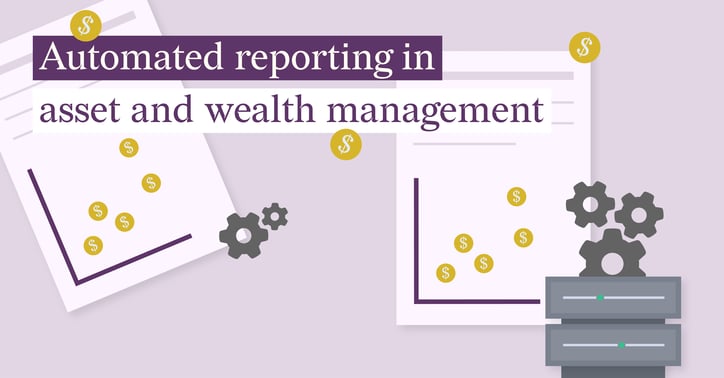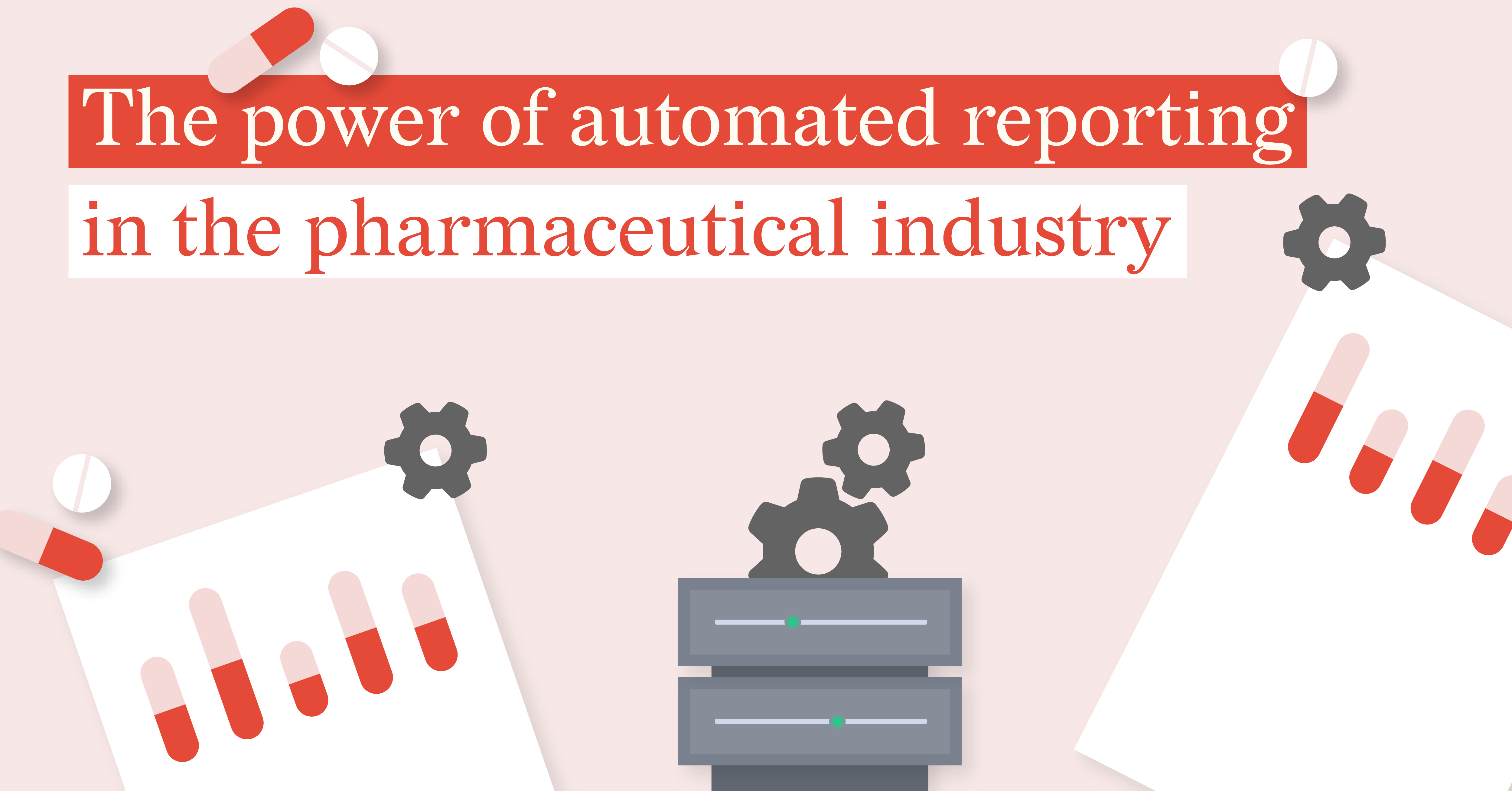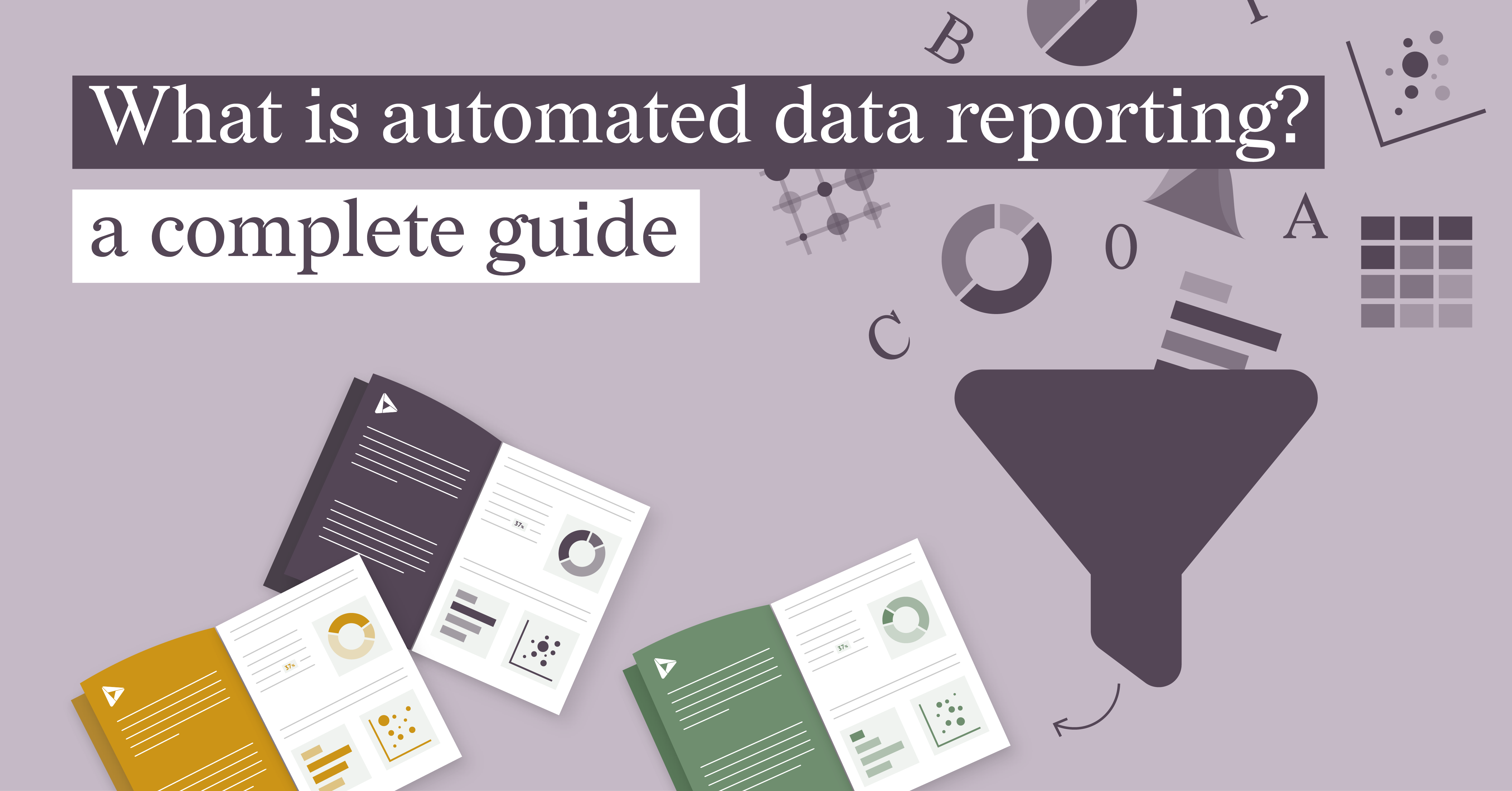Automated Reporting in Asset and Wealth Management: Trends and Best Practices

The complexity of asset and wealth management has reached unprecedented levels as the industry keeps evolving. The increasing volume and diversity of data means that accurate and timely reporting has never been more crucial.
Traditional reporting methods rely on manual processes, and cannot keep up with the demands of modern finance. Not only are these methods time-consuming, but also prone to human error. They often lead to inefficiencies and potential inaccuracies that can significantly impact decision-making and overall business performance.
Enter automated asset and wealth management reporting. This transformative approach addresses the shortcomings of traditional methods. Through automation, you’ll streamline the process of generating customized reports and deliver timely insights.
These systems collect, process, and present data with minimal human intervention. They provide insights that are easy to understand and enhance decision-making capabilities.
Automated reporting offers a significant advantage in asset and wealth management. This technology not only saves time and reduces manual interventions but also ensures consistency and scalability. It enables firms to handle increasing data volumes effortlessly.
Join us as we learn more about the best practices for implementing automated reporting in asset and wealth management. From defining clear reporting goals to selecting appropriate software solutions, we’ll outline strategies that can help organizations leverage automated reporting to enhance data accuracy, increase productivity, and drive cost savings. By embracing these best practices, firms can achieve greater efficiency and competitiveness in the dynamic world of asset and wealth management.
It's important to clarify what we mean by 'automated reporting' in this context. While automation can encompass many reporting styles, our focus here is on the generation of static, multi-page reports. These are not interactive dashboards, but in-depth documents that can be automatically generated. This means reports can be created by connecting to data source and pulling the latest data, all without manual intervention. Additionally, these reports can be delivered 24/7, allowing for on-demand access or even batch generation with the option to create multiple versions for different purposes. Furthermore, data storytelling techniques can be incorporated into these automated static reports to make them not just informative, but also engaging and actionable.
Understanding Automated Reporting
The process of automated reporting simplifies the creation and distribution of reports. It requires automating the different stages of the process including data extraction and creating engaging reports for review. It entails setting up systems that automatically collect, process, and present data into reports. It presents reports as actionable insights for decision-making, without human intervention.
Traditional reporting typically involves extracting data from multiple sources, analyzing it, and creating the findings in a coherent report. This manual approach is labor-intensive and susceptible to delays, reducing the ability of organizations to react swiftly to market changes and emerging trends.
The manual handling of data increases the risk of errors, which can compromise the integrity of financial reports and the decisions based on them. As the volume of data continues to grow, the limitations of traditional reporting become more pronounced. It necessitated a shift towards more efficient and reliable solutions.
A key benefit of automated reporting is the ability to save time and reduce manual interventions. With automated processes, organizations decrease the amount of hours spent on traditional data reporting. This freed-up time allows employees to focus on more strategic tasks instead.
As organizations start using more data sources for reporting, automated systems scale effortlessly to accommodate the increasing volume of information. Using automated reporting also enhances accuracy and scalability by reducing possible human errors. This integration with automated systems ensures consistency in the quality of the reports.
Through day-to-day operations and regular data updates, automated reporting can generate recurring reports based on new data. This new data allows the decision-makers to identify market changes and business needs regularly. It empowers them to make quick decisions as needed.
Reporting tools like Datylon’s automated reporting system allow people to create recurring static reports, automatically. Datylon’s automated reporting system is user-friendly and it is straightforward to customize the report templates according to preferences. Users don’t need to have coding knowledge to create attractive and engaging reports. This reporting tool ensures that insights are easily accessible to a larger audience out and inside the organization.
Before implementing an automated system, it’s crucial to define expectations and goals. This ensures that the reports created meet the requirements of the specific departments or organization as a whole.
Benefits of Automated Reporting in Asset Management
As with any industry, automated reporting presents several key benefits that enhance efficiency and accuracy in asset management. Specifically, when applied to generating static, multi-page reports, automation offers significant advantages.
One key benefit is the reduction of human errors. By automatically connecting to data sources and pulling the latest information, manual data collection is eliminated. This ensures reports are always based on the most current data and minimizes the risk of errors that can occur during manual data entry.
Additionally, integration with data sources allows for on-demand report generation. Reports can be created whenever needed, without the need for manual intervention. This flexibility ensures reports are always up-to-date and readily available for informed decision-making.
Finally, automated reporting streamlines the process. Batch generation with multiple versions empowers users to create reports tailored to specific purposes, reducing the time needed to generate different report variations.
By leveraging these functionalities of automated reporting for static reports, asset management firms can achieve greater efficiency, improve data accuracy, and enhance decision-making capabilities. This ultimately leads to improved performance and competitiveness in the market.
Benefits of Automated Reporting in Wealth Management
Along with streamlining processes in wealth management, automated reporting also reduces operational costs. Compared to manual reporting processes, it saves organizations time and effort.
Automated reporting empowers wealth managers to gain quick insights into spending patterns through static reports. These reports provide clear breakdowns of income and expenditure, all readily available on-demand, which can encourage better decision-making and budget management.
Automated wealth management reports can show expense information within these static reports. This consolidated view simplifies the process of analyzing various performance indicators. Stakeholders and decision-makers can then leverage these reports to identify potential areas for cost optimization and supplier negotiation.
Static reports generated through automated reporting offer an additional benefit – they can aid in risk management and fraud prevention. These reports consolidate expense information, allowing for easier identification of discrepancies and irregularities. This empowers wealth managers to proactively address potential issues and enhance the overall financial security of their clients.
Challenges and Considerations
While automated reporting offers significant benefits, there are also challenges to consider for successful implementation in asset and wealth management. Understanding these challenges is crucial for maximizing the effectiveness of your reporting system:
- Data Integration and Quality: A key challenge lies in integrating data from various sources used in asset and wealth management. This might include portfolio management systems, accounting software, and customer relationship management (CRM) tools. Ensuring seamless data flow and consistent data quality across these systems is essential for generating accurate and reliable reports.
- Regulatory Compliance: Meeting regulatory requirements is a constant challenge in both asset and wealth management. Automated reporting can help ensure timely and accurate reports, but staying current on evolving regulations is crucial to avoid penalties and maintain transparency.
- Report Design and Customization: Automated reporting allows for some level of customization, but it's important to strike a balance. Reports need to meet the specific needs of different stakeholders within asset and wealth management, while still being efficient to generate. Designing overly rigid reports or neglecting user needs can hinder the effectiveness of the system.
- Resource Optimization and Scalability: Optimizing resources and leveraging technology become critical in wealth management, especially as operations become more complex. Automated reporting can help streamline processes, but it's important to consider long-term scalability. Over-automation or neglecting system maintenance can lead to problems down the road.
By being aware of these potential challenges, you can take steps to mitigate them and ensure a successful implementation of automated reporting in your asset and wealth management operations.
Future Trends in Automated Reporting
The asset and wealth management industry is embracing automated reporting and the benefits it offers. Here are some key future trends in automated reporting:
- Artificial Intelligence (AI) and Machine Learning (ML) will play a larger role in automated reporting. By analyzing vast amounts of data and identifying patterns, these technologies can provide more accurate predictions and insights. They’ll help asset and wealth managers make more informed decisions.
- Robotic Process Automation (RPA) will automate routine tasks like data entry, reconciliation, and reporting processes. These tasks free up human resources to focus on more strategic tasks. RPA will lift the burden of repetitive work, enabling firms to streamline processes and improve operational efficiency.
- Asset and wealth managers are increasingly leveraging big data analytics to gain a competitive edge. By harnessing large and diverse datasets, firms can uncover unique insights, identify investment opportunities, and manage risk effectively.
- The trend of socially responsible investing (SRI) is expected to continue growing. Investors are increasingly incorporating Environmental, Social, and Governance (ESG) factors into their portfolios. They’re actively seeking out companies and funds that align with their values. Wealth managers must adapt their reporting to showcase ESG-related metrics and performance.
- AI and ML will enable more personalized wealth management. These technologies can analyze individual investor preferences, risk tolerances, financial goals, and other relevant factors to create tailored investment strategies and reporting. Personalized reporting improves the client experience and helps retain investors.
The future of automated reporting in asset and wealth management is driven by the integration of the points mentioned above. By embracing these trends, firms can streamline operations, enhance analysis, and provide a superior client experience.
Best Practices of Automated Reporting in Asset and Wealth Management
Automated reporting is a powerful tool for asset and wealth management. The benefits are undeniable, from saving time to clearer insights. To fully leverage these advantages, however, firms must follow best practices when implementing automated reporting systems.
Here are some key strategies to ensure successful adoption and optimal outcomes:
Define Clear Reporting Goals
Setting clear reporting objectives is the foundation of effective automated reporting. Ensure that the data gathered and reported aligns with your business objectives. Establishing a regular reporting schedule helps to keep stakeholders informed and aids in optimal asset management.
This alignment ensures that the automated reports generated provide meaningful and actionable insights that drive strategic decision-making.
Optimize Workflows
Optimizing workflows is crucial for the successful implementation of automated reporting systems. Start by documenting current workflow steps and information handoffs in detail. This step helps to identify bottlenecks, redundant steps, and opportunities for automation.
Integrated platforms can help eliminate silos between departments, standardizing workflows across the firm. Continuous feedback from users is essential to refine workflows, and ongoing training ensures staff can adapt to new processes efficiently.
Select Appropriate Software Solutions
Choosing the right software solutions is critical for effective automation. Research various automation tools for different processes and select applications that best fit your needs and technical environment.
Leverage opportunities like the Datylon free trial to test products to determine its potential and address any issues before scaling. This approach minimizes risks and ensures a smoother transition to automated reporting.
Ensure Ease of Use and Actionable Insights
The usability of automated reporting tools is vital. Reports should be easy to read and provide actionable insights that support strategic decision-making.
Integrate robust data management infrastructure with portfolio management and trading software. This ensures that advisors have access to comprehensive and relevant data. It also helps deliver clear insights that are crucial for managing assets and making informed decisions.
This seamless access to actionable data can be achieved through embedded reporting with the Datylon Report Server. Datylon integrates directly with your existing software, ensuring advisors have all the information they need at their fingertips, directly within their portfolio management workflow.
Involve Staff and Promote Upskilling
Involving staff early in the automation planning process is essential for smooth implementation. Gather input on workflow design and solution evaluation from those who’ll be using the systems.
Encourage upskilling through training programs to transition staff to new roles, preventing job losses and enhancing their capabilities. Clearly communicate the benefits of automated reporting, like quickly finding new revenue opportunities, workplace efficiencies, and more time for advisor-client interactions, to gain staff support.
Monitor Outcomes and Continuously Improve
Monitoring outcomes is necessary to ensure the effectiveness of automated reporting systems. Track key performance indicators (KPIs) like cycle times, error rates, cost reductions, productivity gains, revenue, client satisfaction, and system usability.
Conduct ongoing metrics monitoring and reviews to ensure a full return on investment (ROI) and identify areas for improvement. Continuous improvement is key to maintaining the efficiency and effectiveness of automated reporting systems.
By following these best practices, asset and wealth management firms can successfully implement automated reporting. Embracing automated reporting not only streamlines operations but also provides a competitive edge in the ever-evolving financial landscape
Conclusion
With the increasing need for accurate, efficient, and timely reporting, automation has proven to have the upper hand against traditional methods. The shift towards automated asset and wealth management reporting represents a significant step forward. It offers a more efficient, reliable, and scalable solution to the challenges faced by financial professionals.
Automated reporting transforms the way data is collected, processed, and presented. It reduces the burden of manual interventions and minimizes the risk of errors. This technology provides regular on-demand insights, enabling organizations to make swift, informed decisions that can enhance performance and competitiveness. By automating routine tasks and streamlining workflows, firms can free up valuable resources to focus on more strategic activities, ultimately driving better outcomes for their clients.
Implementing automated reporting successfully requires careful planning and adherence to best practices. Defining clear reporting goals ensures that the data collected aligns with business objectives and provides actionable insights.
Optimizing workflows, selecting appropriate software solutions, and ensuring ease of use are crucial steps in the process. Involving staff in the planning and promoting upskilling through training programs helps in smooth adoption and maximizes the benefits of automated reporting. Continuous monitoring and improvement ensure that the system remains effective and delivers the desired return on investment.
By following these best practices, asset and wealth management firms can harness the full potential of automated reporting. This not only enhances data accuracy and productivity but also drives significant cost savings and improves client experiences.
Embracing automated reporting is not just a technological upgrade; it’s a strategic move that positions firms for success in a highly competitive and rapidly changing industry. As we move forward, the integration of advanced technologies like AI and machine learning will further revolutionize reporting, offering even greater opportunities for innovation and growth.
Are you ready to take the leap to revolutionizing how your firm reports its data? Contact our team of experts or book a demo today to find out more about our system and how it’ll propel your firm into a new level of efficiency.
👉If you're keen on crafting custom data visualizations, visit our Bespoke Data Visualization Solutions page.
Additional Resources
What is automated data reporting? A complete guide
Climbing the Ladder of Automated Reporting Solutions with Datylon
The Great Report Debate: Manual, Automated, or Interactive?
Automated reports: Defining Data Resources, Data Extraction and Transformation Options
Mastering Versioned Stand-Alone Reports
Building an automated reporting solution with Datylon Report Server
Automated Data Visualization Trends: What to Look for in Report Server Tools
Automated reporting for various industries:
Revolutionizing Marketing and Media: The Power of Automated Reporting
Boosting Efficiency: How Automated Reporting Transforms Associations
The Power of Automated Reporting in the Pharmaceutical Industry
Why embedded reporting is a game changer for SaaS companies
Julia Vorontsova - Chief Marketing Officer
Julia Vorontsova, a seasoned marketer and the CMO of the company, finds joy in guiding businesses through growth. Based in Belgium, having recently relocated from Canada, she immerses herself in diverse cultures while nurturing her passions for travel and jazz.



